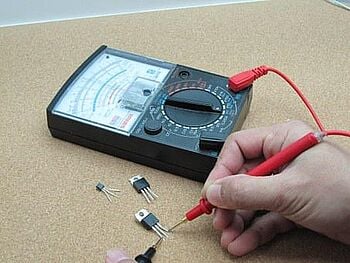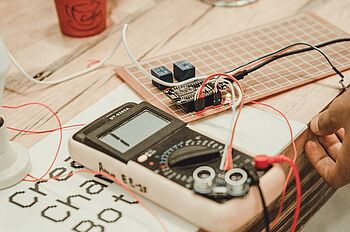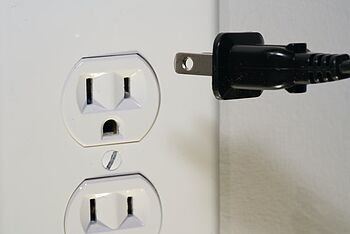- Introduction
- What Are the Types of Digital Multimeters?
- Typical DMM Controls and Connections
- What Is the Difference Between an Analog Multimeter and a Digital Multimeter?
- Why Is the Polarity of Analog and Digital Multimeters Different?
- What Are the Benefits of Using Digital Multimeters?
- What Should I Look For in a Digital Multimeter?
- DMM Accuracy
- How To Use a Digital Multimeter
- Testing Electrical Outlets
- Keysight Multimeters
- Popular Used Oscilloscopes
What is a Digital Multimeter?
A digital multimeter, also known as a DMM, is an electronic device that tests and measures various electrical values. These quantities can include voltage, current, and resistance. DMMs are essential tools for any electrician or electronics technician, as they allow for quick and accurate measurements of various electrical parameters.
Digital multimeters typically have a large LCD screen that shows the measured quantity in a digital readout. Some DMMs also have a built-in analog meter that can visualize the measurement. Most DMMs will also have a variety of different functions and features, such as the ability to measure AC or DC quantities, as well as test for continuity and resistance.
DMMs are invaluable tools for anyone testing electrical systems or electronics. They are relatively easy to use and provide fast, accurate measurements of various electrical quantities. With a digital multimeter, you can quickly troubleshoot electrical issues and ensure that your circuits are functioning correctly.

Buy Multimeter at a Great Discount
What Are the Types of Digital Multimeters?
Digital multimeters come in a variety of different types, each designed for specific tasks and measurements. The most common type of DMM is the handheld DMM, which is small and portable, making it ideal for taking measurements in the field. Benchtop DMMs are larger and more expensive but offer more features and higher accuracy.
Multimeters can also be classified by their input type. Most DMMs will have both AC/DC voltage inputs, but some may only have one or the other. AC multimeters are designed for measuring alternating current readings, while DC multimeters are designed to read direct current measurements. There are also special types of multimeters, such as true RMS multimeters, which are designed for measuring AC quantities that have a sinusoidal or non-sinusoidal waveform.
Digital multimeters can also be classified by the range of values they can measure. Some DMMs can only measure small ranges, while others have a much wider range. The range of a DMM is typically expressed in terms of volts, amperes, or ohms. For example, a DMM with a range of 0-1000 V can measure voltages from 0 to 1000 volts.
Typical DMM Controls and Connections
A DMM typically has various controls that allow the user to select the desired measurement mode and range. They also have a variety of connections that allow them to be used with different devices and circuits.
The most common types of controls on a digital multimeter are:
- Mode selector. This switch selects the desired measurement mode, such as AC voltage, DC voltage, or resistance. The mode selector switch is usually located on the front of the multimeter.
- Range selector. This is used to select the desired measurement range of a particular mode. The range selector switch is also located on the front of the multimeter.
- Ports. These are used to plug in leads or other probes used in testing. The ports are often located at the bottom of the meter.
Digital multimeters also have a variety of different input types that allow them to be used with a variety of different devices and circuits. The most common input types are AC voltage and DC voltage, but some multimeters also have specific inputs for measuring alternating current that has a non-sinusoidal waveform.
They also have various display types that allow them to show the measured quantity in either digital or analog form. Some multimeters also have a built-in analog meter that can be used to visualize the measurement.
What Is the Difference Between an Analog Multimeter and a Digital Multimeter?
| Analog | Digital |
|---|---|
Uses a needle pointer to display the measurement. Can sometimes be difficult to read | Uses a digital display to show the measurement, making it much easier to read |
Usually less expensive to purchase | Has a broader range of functions, meaning they can be more costly |
Needs calibration often | Calibrates automatically |
Can only be used to measure current, voltage, and resistance | Can be used to measure current, voltage, resistance, capacitance, inductance, impedance, diode testing, transistor testing, and capacitor testing |
Simple to use, and basic in functionality | Can store measurements in memory, take multiple readings at once, and print out measurements. |

Why Is the Polarity of Analog and Digital Multimeters Different?
The polarity of analog and digital multimeters is different because they measure voltage in different ways. Analog multimeters measure voltage by applying a small current to the circuit and measuring the voltage drop across a resistor. This voltage drop is caused by the current flowing through the resistor. Digital multimeters, on the other hand, measure voltage by sampling the voltage at the input terminals and converting it to a digital value. The direction of the digital conversion determines the polarity of the digital multimeter.
What Are the Benefits of Using Digital Multimeters?
Digital multimeters offer several advantages over their analog counterparts. Some of the most significant advantages are:
- They give much more accurate readings than analog multimeters. This is because digital multimeters use digital technology to take measurements, which eliminates the need for analog-to-digital conversion. This results in more accurate measurements, particularly when measuring AC quantities.
- Another advantage of digital multimeters is that they are much easier to use than analog multimeters. With a digital multimeter, you simply select the function you want to measure and then connect the leads to the appropriate terminals. There is no need to worry about setting the correct range or dialing in the correct measurement. Simply select the function and let the multimeter do the rest.
- Depending on the model, digital multimeters also offer several other benefits, such as the ability to store measurements in memory, take multiple readings at once, and print out measurements. These features can be extremely helpful when performing complex measurements or when taking measurements over a period of time.
What Should I Look For in a Digital Multimeter?
When choosing a DMM, you should consider the following factors:
- Accuracy: A digital multimeter's accuracy is the degree to which the multimeter can measure a quantity. The accuracy is typically expressed as a percentage of full scale (F.S.). For example, if a digital multimeter has an accuracy of 0.5% F.S., it can measure a quantity to within 0.5% of the full scale.
- Resolution: A digital multimeter’s resolution is the smallest change in quantity that the multimeter can measure. The resolution is typically expressed as a number of digits, where more digits provide higher resolution. For example, if a digital multimeter has a resolution of 4.5 digits, it can measure changes in the quantity to within 1 part in 30,000 (or 0.0033%).
- Range: The range of a DMM is the span of values the multimeter can measure for a given function (such as voltage, current, or resistance). The range is typically expressed in units, such as volts, amps, or ohms. For example, if a digital multimeter has a voltage range of 0 to 50 V, it can measure voltage values from 0 V up to 50 V. The range does not represent a percentage of full scale, but rather the specific limits of measurement.
- Sampling rate: The sampling rate of a multimeter is the rate at which the multimeter takes measurements. The sampling rate is typically expressed as a number of samples per second (S/s). For example, if a digital multimeter has a sampling rate of 1 S/s, it takes one measurement every second.
DMM Accuracy
Accuracy and precise readings are critical when working with electrical quantities. Digital multimeters offer a high degree of accuracy, making them the preferred choice for many applications.
They are available with an overall accuracy of:
- 0.1%
- 0.2%
- 0.5%.
The 0.5% and 0.2% accuracy levels are suitable for most general-purpose applications. The 0.1% accuracy level is typically only necessary for industrial or scientific applications.
How To Use a Digital Multimeter
Digital multimeters are relatively simple to use and can be a great way to troubleshoot electrical issues quickly. When using a DMM, follow these steps:
- Select the correct measurement mode for the quantity you wish to measure
- Select the applicable range
- Connect the leads of the multimeter to the correct ports
- Test the circuit
- The multimeter will then take the measurement and display the result on the screen.
Now that we have looked at the differences between digital and analog multimeters and the benefits of using a DMM, let's look at some other uses and features.

Testing Electrical Outlets
There are a few tests you can do to inspect the integrity of an electrical outlet. First, set the multimeter to the AC voltage setting. Then, plug the multimeter into the outlet and take a reading. The reading should be within the normal range for your home’s voltage. If the reading is outside of the normal range, there may be a problem with the outlet.
If you’re testing for a short circuit, first, set the multimeter to the resistance setting. Then, touch the probes to the terminals of the outlet. The reading should be infinity. If the reading is not infinity, there may be a problem with the outlet.
If you want to test for a ground (earth) fault, set the multimeter to the resistance setting. Then, touch one probe to the ground terminal of the outlet and the other probe to the hot terminal of the outlet. The reading should be zero. If the reading is not zero, there may be a problem with the outlet.

Browse Multimeters at a Great Discount
Keysight Multimeters
As we have looked at, a digital multimeter is a valuable tool for troubleshooting circuits and verifying the operation of electrical and electronic circuits. If you need to test or measure quantities such as voltage, current or resistance, a digital multimeter is the right tool for the job.
To learn more about the features of used Keysight Multimeters and to see the wide variety of products we sell at discounted rates, visit Keysight Used Equipment.
Popular Used Oscilloscopes
Keysight Used Oscilloscopes offers a wide range of industry leading pre-owened oscilloscopes, ranging from older generation Agilent oscilloscopes to the newest Keysight oscilloscope models. So whether you are a fist time buyer, replacing a model like-for-like or looking for upgrade – we have something for you.
Frequently Asked Questions
What Is a Pass/Fail Signal Output?
A pass/fail signal output is a type of digital output that indicates whether a measurement is within the acceptable range or not. The output is typically a simple LED that is either ON or OFF. If the measurement is within the acceptable range, the LED will be ON. If the measurement is outside of the acceptable range, the LED will be OFF.
What Is a Temperature Measurement?
Temperature measurement is a type of measurement that is used to determine the temperature of an object. Temperature measurements are typically made with a thermocouple or a resistive temperature device (RTD). Thermocouples and RTDs are special sensors that change resistance with temperature. The resistance of the sensor is measured and converted to a temperature reading.
What Is the RX1 Setting on a Digital Multimeter?
The RX1 setting on a DMM is the range setting for measuring resistance. The RX1 setting can be used for very low resistance measurements, such as those of less than 1 ohm. When the RX1 setting is selected, the digital multimeter measures the voltage across the terminals and divides it by the value of the measured resistance to calculate the current.














































